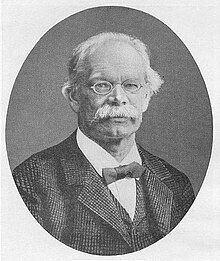Kurt Wachsmuth

Kurt Wachsmuth , also Curt Wachsmuth (born April 27, 1837 in Naumburg (Saale) , † June 8, 1905 in Leipzig ) was a German classical philologist and ancient historian .
Life
Kurt Wachsmuth was the son of the judiciary Julius Wachsmuth (1803–1877). Educated from the Pforta State School , he studied in Jena and Bonn since 1856 . During his studies in 1856 he became a member of the Arminia fraternity in the castle cellar . After spending six months in Berlin as a teacher at the Joachimsthalschen Gymnasium , he went to Italy with an archaeological travel grant in the fall of 1860 , served as a secretaire interpreter at the Prussian legation in Athens in 1861 , completed his habilitation in Bonn in 1862 for classical philology and ancient history, and became a full professor in 1864 in Marburg , 1868 in Göttingen and Easter 1877 in Heidelberg . From 1886, Wachsmuth taught in Leipzig, where he took over the chair for Ancient History and Classical Philology as the successor to the philologist Ludwig Lange . He was also head of the historical and philological seminar at Leipzig University. His successor in the ancient history chair was Ulrich Wilcken in 1906 . Wachsmuth was rector of Marburg University in 1868/69 and rector of Leipzig University in 1897/98 . In 1884 he was elected a corresponding member of the Göttingen Academy of Sciences . Since 1891 he was a foreign member of the Bavarian Academy of Sciences .
Wachsmuth's interest was not limited to history or philology. So it happened that, like Karl Lamprecht , he gave scientific lectures and the like. a. of the chemist Wilhelm Ostwald attended. This is also attested by a photo in Ostwald's Lebenslinien , published in 1927 , on which, during a lecture by Ostwald with an experiment, Wachsmuth and Lamprecht can be seen among the audience.
There is no close family relationship with the ancient historian and cultural historian Ernst Wilhelm Gottlieb Wachsmuth , who also teaches in Leipzig .
Wachsmuth was married to Marie Luise Henriette born in 1865. Ritschl, the daughter of the philologist Friedrich Ritschl . With her he had a son, the physicist Richard Wachsmuth .
plant
In addition to his importance as a philologist, Wachsmuth was particularly important as an ancient historian with his topography of Greece and especially of ancient Athens . His description of Athens can be considered a masterpiece for the criticism of ancient sources, even if it has remained unfinished. It ends with the time of Justinian I. The story of the city of Athens in the Middle Ages by Ferdinand Gregorovius follows immediately.
Although many of Wachsmuth's conclusions are no longer tenable due to more recent archaeological results, we still have the credit for having placed the relevant ancient sources, especially for the topography of Athens, in a contextual context. The contemporary archaeological literature was used intensively.
In Wachsmuth's work, classical philology and ancient history merged to a degree that also made up his reputation as a scholar, a kind of crossroads for both disciplines. The philologist Justus Hermann Lipsius made this clear with the words: “The last representative of that learned generation in which two divergent fields of study, the classical philological and the ancient historical, merged into one unit. ". From this point of view, his introduction to the study of ancient history (Leipzig, 1895) also deserves attention.
At the idea of Wachsmuth in 1866, the archaeological collection of casts was founded in Marburg.
Works
- "De Timone Phliasio ceterisque sillographis graecis" (Leipz. 1859)
- "De Cratete Mallota" (that. 1860)
- "Old Greece in the new" (Bonn 1864)
- "The city of Athens in antiquity" (Vol. 1, Leipz. 1874, Vol. 2, 1890)
- "Studies on the Greek Florilegia" (Berl. 1882)
- Editions of "Lydus de ostentis" and the Greek calendars (Leipz. 1863), the Stobäus (Berl. 1884, vol.) And der Sillographorum graecorum reliquiae "(Leipz. 1885).
literature
- Justus Hermann Lipsius : Words in memory of Curt Wachsmuth . In: Reports on the negotiations of the Royal Saxon Society of Sciences in Leipzig, philological-historical class . Volume 57 (1905), pp. 287-297
- Bruno Albin Müller : Curt Wachsmuth . In: Biographisches Jahrbuch für Altertumskunde , 30th year (1907), pp. 167–194.
- German Biographical Encyclopedia , Vol. 10, p. 266.
Web links
- Literature by and about Kurt Wachsmuth in the catalog of the German National Library
- Overview of Kurt Wachsmuth's courses at the University of Leipzig (summer semester 1886 to summer semester 1905)
- Kurt Wachsmuth in the professorial catalog of the University of Leipzig
- http://www.uni-leipzig.de/~unineu/journal/gesichter/0604.html
- https://web.archive.org/web/20061205110843/http://web.uni-marburg.de/zv/news/archiv/muj12/MUJ12-pdf/42-46.pdf (PDF file; 722 kB )
Individual evidence
- ↑ Fraternity leaves . XIV., Berlin 1900, p. 281.
- ↑ Rector's speeches (HKM)
- ↑ Holger Krahnke: The members of the Academy of Sciences in Göttingen 1751-2001 (= Treatises of the Academy of Sciences in Göttingen, Philological-Historical Class. Volume 3, Vol. 246 = Treatises of the Academy of Sciences in Göttingen, Mathematical-Physical Class. Episode 3, vol. 50). Vandenhoeck & Ruprecht, Göttingen 2001, ISBN 3-525-82516-1 , p. 249.
- ↑ Wachsmuth, Curt. Hessian biography (as of February 23, 2015). In: Landesgeschichtliches Informationssystem Hessen (LAGIS). Hessian State Office for Historical Cultural Studies (HLGL), accessed on March 16, 2016 .
| personal data | |
|---|---|
| SURNAME | Wachsmuth, Kurt |
| ALTERNATIVE NAMES | Wachsmuth, Curt |
| BRIEF DESCRIPTION | German classical philologist and ancient historian |
| DATE OF BIRTH | April 27, 1837 |
| PLACE OF BIRTH | Naumburg (Saale) |
| DATE OF DEATH | June 8, 1905 |
| Place of death | Leipzig |


